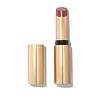What's inside
What's inside
 Key Ingredients
Key Ingredients

 Benefits
Benefits

 Concerns
Concerns

 Ingredients Side-by-side
Ingredients Side-by-side

Diisostearoyl Polyglyceryl-3 Dimer Dilinoleate
EmollientRicinus Communis Seed Oil
MaskingOctyldodecanol
EmollientPrunus Amygdalus Dulcis Oil
Skin ConditioningHydrogenated Vegetable Glyceride
EmollientSimmondsia Chinensis Seed Oil
EmollientMica
Cosmetic ColorantParfum
MaskingTocopherol
AntioxidantButyrospermum Parkii Butter
Skin ConditioningArgania Spinosa Kernel Oil
EmollientHelianthus Annuus Seed Oil
EmollientLimonene
PerfumingCitral
PerfumingLinalool
PerfumingCitronellol
PerfumingCI 77891
Cosmetic ColorantCI 77491
Cosmetic ColorantCI 77492
Cosmetic ColorantCI 77499
Cosmetic ColorantCI 75470
Cosmetic ColorantCI 77742
Cosmetic ColorantCI 15850
Cosmetic ColorantDiisostearoyl Polyglyceryl-3 Dimer Dilinoleate, Ricinus Communis Seed Oil, Octyldodecanol, Prunus Amygdalus Dulcis Oil, Hydrogenated Vegetable Glyceride, Simmondsia Chinensis Seed Oil, Mica, Parfum, Tocopherol, Butyrospermum Parkii Butter, Argania Spinosa Kernel Oil, Helianthus Annuus Seed Oil, Limonene, Citral, Linalool, Citronellol, CI 77891, CI 77491, CI 77492, CI 77499, CI 75470, CI 77742, CI 15850
Polyglyceryl-2 Triisostearate
EmulsifyingPolyglyceryl-6 Polyricinoleate
EmulsifyingOctyldodecanol
EmollientBis-Diglyceryl Polyacyladipate-2
EmollientPolyglyceryl-3 Diisostearate
EmulsifyingEuphorbia Cerifera Wax
Vp/Eicosene Copolymer
Synthetic Wax
AbrasiveSimmondsia Chinensis Seed Oil
EmollientAroma
Ethylene/Propylene Copolymer
AbrasiveLimnanthes Alba Seed Oil
Skin ConditioningDicalcium Phosphate
AbrasiveAstrocaryum Murumuru Seed Butter
EmollientPunica Granatum Flower Extract
Skin ConditioningPentaerythrityl Tetra-Di-T-Butyl Hydroxyhydrocinnamate
AntioxidantButyrospermum Parkii Butter Extract
Skin ConditioningIrvingia Gabonensis Kernel Butter
Skin ConditioningHydrogenated Coco-Glycerides
EmollientDisteardimonium Hectorite
StabilisingPolyhydroxystearic Acid
EmulsifyingIron Oxides
CI 77891
Cosmetic ColorantCI 15850
Cosmetic ColorantCI 42090
Cosmetic ColorantPolyglyceryl-2 Triisostearate, Polyglyceryl-6 Polyricinoleate, Octyldodecanol, Bis-Diglyceryl Polyacyladipate-2, Polyglyceryl-3 Diisostearate, Euphorbia Cerifera Wax, Vp/Eicosene Copolymer, Synthetic Wax, Simmondsia Chinensis Seed Oil, Aroma, Ethylene/Propylene Copolymer, Limnanthes Alba Seed Oil, Dicalcium Phosphate, Astrocaryum Murumuru Seed Butter, Punica Granatum Flower Extract, Pentaerythrityl Tetra-Di-T-Butyl Hydroxyhydrocinnamate, Butyrospermum Parkii Butter Extract, Irvingia Gabonensis Kernel Butter, Hydrogenated Coco-Glycerides, Disteardimonium Hectorite, Polyhydroxystearic Acid, Iron Oxides, CI 77891, CI 15850, CI 42090
Ingredients Explained
These ingredients are found in both products.
Ingredients higher up in an ingredient list are typically present in a larger amount.
Ci 15850 is the pigment color red. It is an azo dye and created synthetically.
Azo dyes need to be thoroughly purified before use. This allows them to be more stable and longer-lasting.
This ingredient is common in foundations, lipsticks, and blushes. This color is described as brown/orangey red.
It has many secondary names such as Red 6 and Red 7. According to a manufacturer, Red 6 usually contains aluminum.
Learn more about CI 15850Ci 77891 is a white pigment from Titanium dioxide. It is naturally found in minerals such as rutile and ilmenite.
It's main function is to add a white color to cosmetics. It can also be mixed with other colors to create different shades.
Ci 77891 is commonly found in sunscreens due to its ability to block UV rays.
Learn more about CI 77891Octyldodecanol is a fatty alcohol. It is primarily used to enhance the texture of products.
As an emulsifier, Octyldodecanol helps prevent the oils and waters from separating. It also prevents ingredients from creating foam when shaken.
Octyldodecanol is created by reducing fatty acid to an alcohol.
Due to its high molecular weight, it does not get absorbed into the skin.
Learn more about OctyldodecanolThis oil comes from the seeds of the desert shrub called Jojoba. It is more commonly known as jojoba oil, a non-comedogenic oil.
Jojoba oil does not contain fragrance and has many fatty-acids, making it a great soothing ingredient.
It also contains Vitamin E, a great moisturizing ingredient. Vitamin E is also an antioxidant and protects your skin against oxidative damage.
This ingredient humectant properties, meaning it helps draw moisture from the air. This helps keep your skin hydrated.
While jojoba has antibacterial properties, it is only able to kill some strains of bacteria.
Studies also show it helps in wound healing. In fact, Indigenous cultures have used jojoba as a moisturizer and to help treat burns for centuries.
Fun fact: Jojoba oil similar to natural human skin sebum, so it has a great effect on dry skin. It is also promising with helping to regulate sebum production.
Due to its fatty acid content, Jojoba oil may not be fungal acne safe. We recommend speaking with a professional if you have any concerns.
Learn more about Simmondsia Chinensis Seed Oil